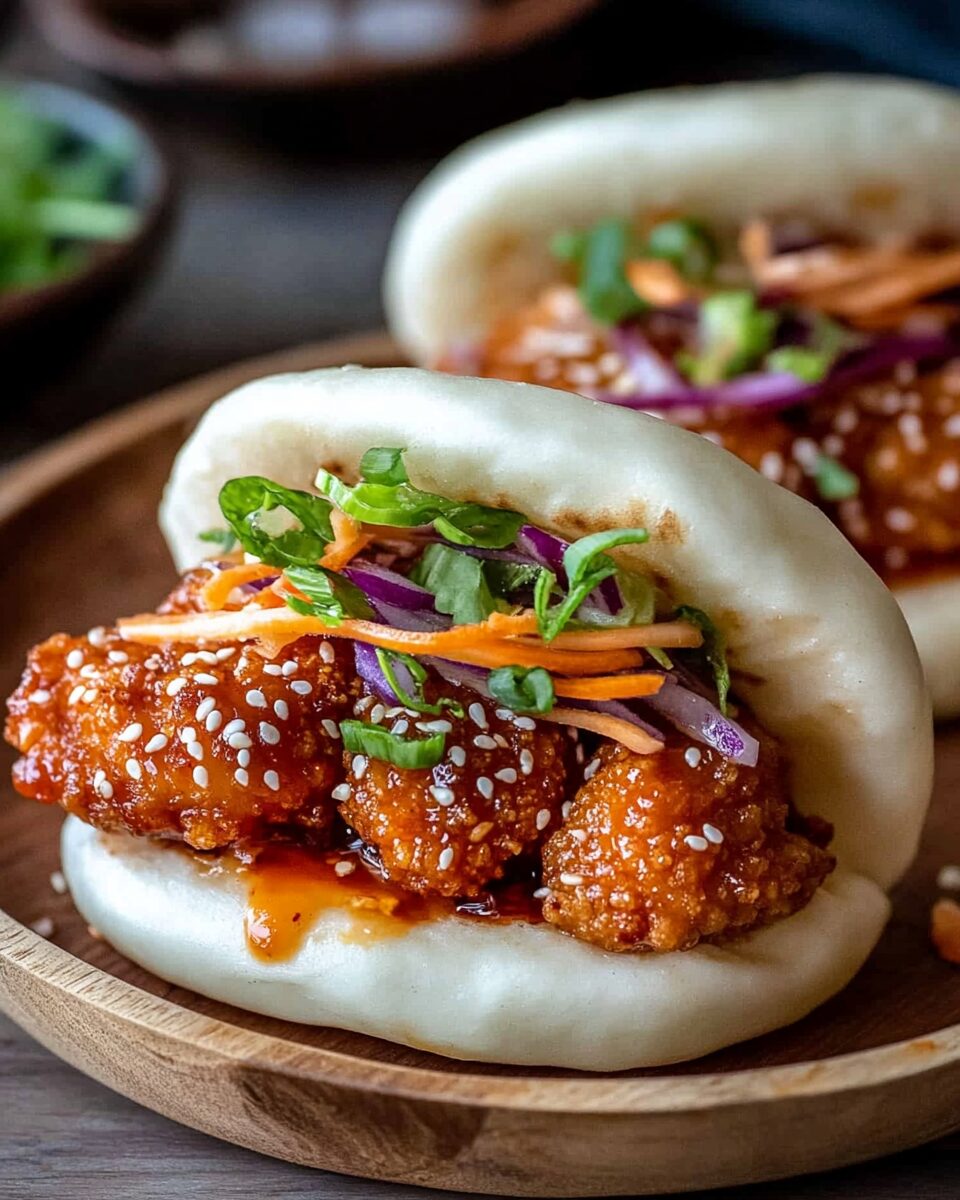The Korean Fried Chicken Bao combines the crispy, spicy goodness of perfectly fried chicken with the soft, pillowy texture of steamed bao buns. This fusion dish brings together bold Korean flavors and comforting street food vibes in every bite.
Each bao is layered with crunchy pickled vegetables and garnished with sesame seeds and fresh cilantro, offering a balance of flavors and textures. It’s the ultimate dish for entertaining, a casual dinner, or impressing guests with a creative and flavorful recipe.
Full Recipe:
Ingredients:
For the Chicken:
- 2 boneless, skinless chicken thighs
- 1 cup all-purpose flour
- 1/2 cup cornstarch
- 1 teaspoon garlic powder
- 1 teaspoon onion powder
- 1 teaspoon smoked paprika
- 1/2 teaspoon salt
- 1/2 teaspoon black pepper
- 1 cup buttermilk
- Oil for frying
For the Sauce:
- 1/4 cup gochujang (Korean chili paste)
- 2 tablespoons honey
- 2 tablespoons soy sauce
- 1 tablespoon rice vinegar
- 2 teaspoons sesame oil
- 1 teaspoon minced garlic
- 1 teaspoon grated ginger
For the Bao Buns and Toppings:
- 6 steamed bao buns
- 1/2 cup julienned carrots
- 1/2 cup cucumber slices
- 1/4 cup thinly sliced radishes
- 2 tablespoons rice vinegar
- 1 tablespoon sugar
- 1/4 teaspoon salt
- Sesame seeds for garnish
- Fresh cilantro leaves
Directions:
- Prepare the pickled vegetables: In a small bowl, combine rice vinegar, sugar, and salt. Mix until dissolved, then add carrots, cucumber, and radishes. Let sit for at least 30 minutes.
- Prepare the chicken: In a bowl, mix flour, cornstarch, garlic powder, onion powder, smoked paprika, salt, and black pepper. In another bowl, pour the buttermilk. Dip the chicken thighs in the buttermilk, then coat them thoroughly in the flour mixture.
- Fry the chicken: Heat oil in a deep skillet or fryer to 350°F (175°C). Fry the chicken until golden brown and cooked through, about 5-7 minutes per side. Drain on paper towels.
- Make the sauce: In a saucepan over medium heat, combine gochujang, honey, soy sauce, rice vinegar, sesame oil, garlic, and ginger. Stir and simmer for 2-3 minutes until thickened.
- Coat the chicken: Toss the fried chicken in the sauce until well coated.
- Assemble the bao: Fill each steamed bao bun with a piece of coated chicken, pickled vegetables, and fresh cilantro. Sprinkle with sesame seeds for garnish.
Prep Time: 20 minutes | Cooking Time: 20 minutes | Total Time: 40 minutes
Kcal: 480 kcal | Servings: 6 servings
The Origin of Korean Fried Chicken Bao
Korean fried chicken, also known as “Chimaek” (a combination of “chicken” and “maekju,” meaning beer), is a beloved dish in South Korea known for its extra-crispy coating and spicy-sweet glaze. Combining this with bao buns—a Chinese steamed bread often used in fusion cuisines—creates a unique dish that blends the best of both worlds. The result is a delicious fusion recipe that brings together the bold, spicy flavors of Korea and the soft, pillowy texture of bao, offering a multicultural culinary experience.
Cooking Tips for the Best Bao Buns and Chicken
- Steaming Bao Buns: For the fluffiest bao buns, steam them over high heat for about 8-10 minutes. Make sure the steamer lid is covered with a kitchen towel to prevent water from dripping onto the buns.
- Perfectly Crispy Chicken: The combination of flour and cornstarch in the batter creates an ultra-crispy coating that stays crunchy even when coated in sauce. For extra crunch, fry the chicken twice: fry it once until pale golden, then let it rest and fry again until deeply golden brown.
- Balancing the Sauce: The gochujang-based sauce is spicy, tangy, and slightly sweet. Adjust the sweetness with honey or sugar to suit your taste. You can also add a splash of lime juice for an extra zing.
Serving Suggestions
- Pair these bao buns with a side of kimchi for an authentic Korean touch. The tangy, fermented flavors complement the richness of the chicken perfectly.
- A fresh salad of shredded cabbage, carrots, and sesame dressing can provide a refreshing crunch.
- For drinks, a chilled glass of Korean beer or sparkling water infused with lime pairs wonderfully with the bold flavors of this dish.
Customizations and Variations
- Protein Options: You can swap chicken for tofu, shrimp, or even pork belly for different variations of the dish.
- Spice Levels: If you prefer a milder flavor, reduce the gochujang and increase the honey or soy sauce. For heat lovers, add a pinch of chili flakes or a drizzle of chili oil.
- Bao Bun Substitutes: If you can’t find bao buns, use soft slider buns or tortilla wraps as an alternative.
- Pickled Veggies: Experiment with pickling other vegetables like red onions, jalapeños, or daikon radish to add more flavor diversity.
Why This Recipe is a Must-Try
This recipe is perfect for adventurous home cooks who love experimenting with global flavors. It’s versatile, impressive enough for dinner parties, and a fun way to introduce Korean-inspired cuisine to your friends and family. Plus, the combination of crispy chicken and soft bao buns makes it a surefire hit with all age groups!
What Makes Korean Fried Chicken Special?
Korean fried chicken stands out because of its signature double-frying method, which creates an exceptionally crispy exterior while keeping the meat juicy and tender. The batter often incorporates cornstarch for that delicate crunch, and the sauce—typically made with gochujang (Korean chili paste)—delivers an irresistible balance of spicy, sweet, and savory flavors. Unlike many Western fried chicken recipes, Korean fried chicken is typically lighter, less greasy, and coated with a thin layer of sauce to enhance its flavor without overpowering the texture.
The Art of Making Bao Buns
Bao buns, also known as lotus leaf buns, are a staple in Chinese cuisine and have become increasingly popular in fusion recipes. Their soft, slightly sweet, and fluffy texture makes them the perfect vehicle for holding bold fillings like Korean fried chicken. These buns are steamed rather than baked, which gives them their pillowy structure. Many home cooks purchase ready-made buns, but making them from scratch allows you to control their size, flavor, and texture.
Key Ingredients and Their Role
- Gochujang: This Korean chili paste is the star of the sauce, bringing a fermented depth of flavor with a combination of heat and sweetness. It’s widely available in Asian grocery stores and online.
- Pickled Vegetables: Quick-pickling the carrots, cucumbers, and radishes adds a tangy crunch that balances the richness of the fried chicken. The acidity helps cleanse the palate, making every bite feel fresh.
- Buttermilk Marinade: Soaking the chicken in buttermilk tenderizes the meat and helps the coating adhere better, resulting in a crispier crust.
Nutritional Benefits
While this dish is indulgent, you can incorporate elements to make it a more balanced meal:
- Protein-Rich: The chicken provides high-quality protein, which supports muscle growth and repair.
- Veggie Boost: The pickled vegetables not only add flavor but also supply fiber, vitamins, and antioxidants.
- Customizable for Dietary Needs: Swap regular flour for gluten-free flour or use plant-based protein alternatives to cater to various dietary preferences.
Creative Ways to Serve Korean Fried Chicken Bao
- Build-Your-Own Bao Bar: Let guests assemble their own baos with a variety of toppings like kimchi, spicy mayo, and roasted peanuts for a fun and interactive dining experience.
- Mini Bao Sliders: Use smaller bao buns to create bite-sized appetizers, perfect for parties or gatherings.
- Fusion Bowls: If you have leftover chicken and veggies, serve them over steamed rice or noodles for a deconstructed version of this recipe.
Interesting Facts to Engage Your Readers
- Korean fried chicken rose to international fame in the late 20th century, with global chains like Bonchon and Kyochon popularizing it worldwide.
- The name “bao” translates to “bun” in Mandarin, and these buns date back to the Chinese Three Kingdoms period, around 200 AD.
- Fusion dishes like Korean Fried Chicken Bao reflect a growing trend of blending traditional recipes from different cultures to create something entirely new and exciting.
Pro Tips for Flawless Results
- Steaming Bao Buns: If you’re using frozen bao buns, steam them directly from frozen for the best texture—no need to thaw beforehand.
- Maintaining Crispy Chicken: To keep the chicken crispy, only coat it in sauce right before assembling the bao buns.
- Sauce Thickness: If the sauce feels too runny, simmer it longer to thicken or add a small cornstarch slurry for consistency.
Pairing Suggestions
To complement the bold flavors of the bao, consider serving it with:
- A refreshing drink like a chilled cucumber-lime spritzer or traditional Korean rice punch (Sikhye).
- A light side dish such as sesame-dressed green beans or a simple seaweed salad.
- Dessert ideas like mochi ice cream or Korean honey cookies (yakgwa) to end the meal on a sweet note.
Conclusion
Korean Fried Chicken Bao is the perfect marriage of bold Korean flavors and the soft, comforting texture of bao buns. This fusion dish not only brings a delightful mix of crispy, spicy, and tangy elements but also offers a fun and versatile way to enjoy global cuisine. Whether you’re preparing it for a casual dinner, a special gathering, or simply to treat yourself, this recipe is sure to impress. The combination of crispy chicken, vibrant pickled vegetables, and a hint of fresh cilantro makes every bite a harmonious explosion of flavors and textures.
The beauty of this dish lies in its adaptability—you can customize it with different proteins, spice levels, and toppings to suit your preferences. Plus, its eye-catching presentation makes it a crowd-pleaser that’s as fun to look at as it is to eat. Try this recipe today and bring a touch of fusion-inspired culinary magic to your kitchen!






